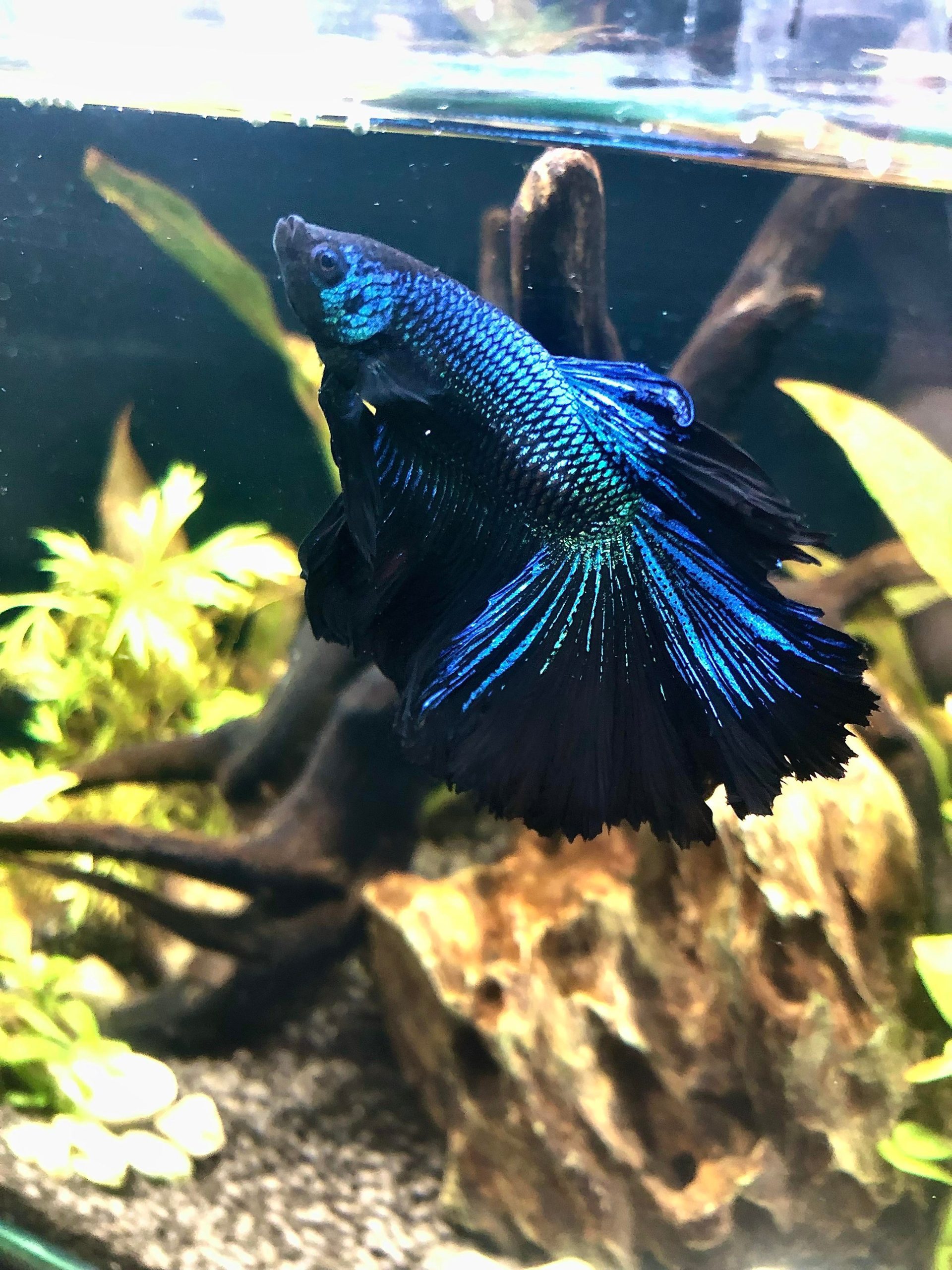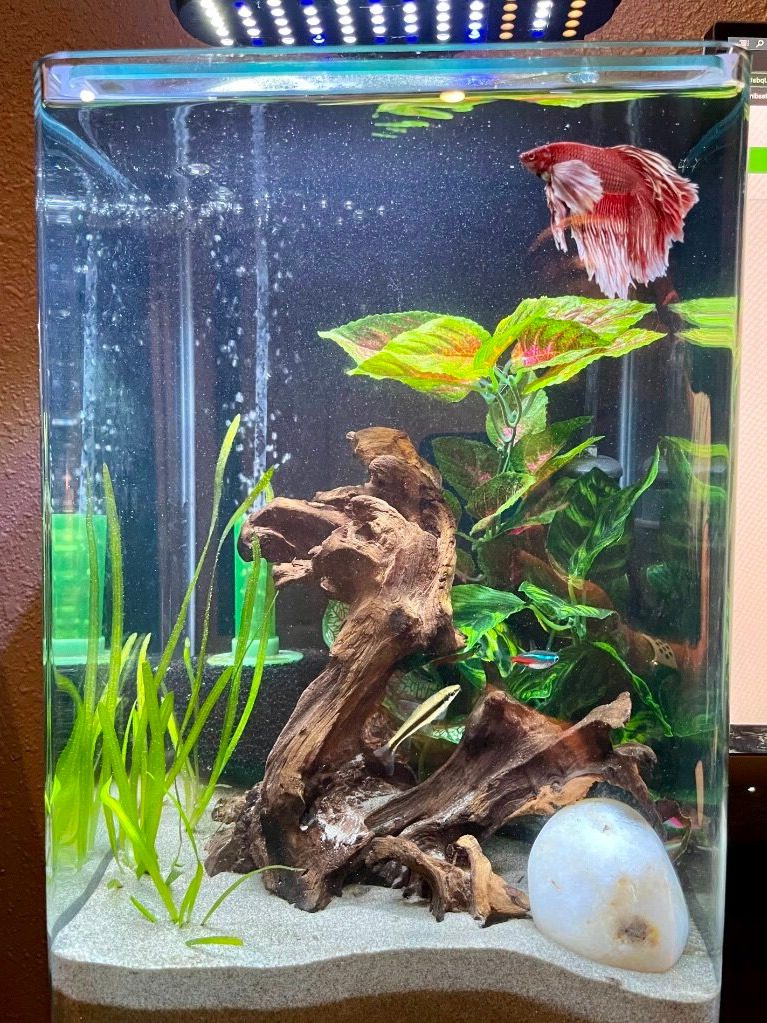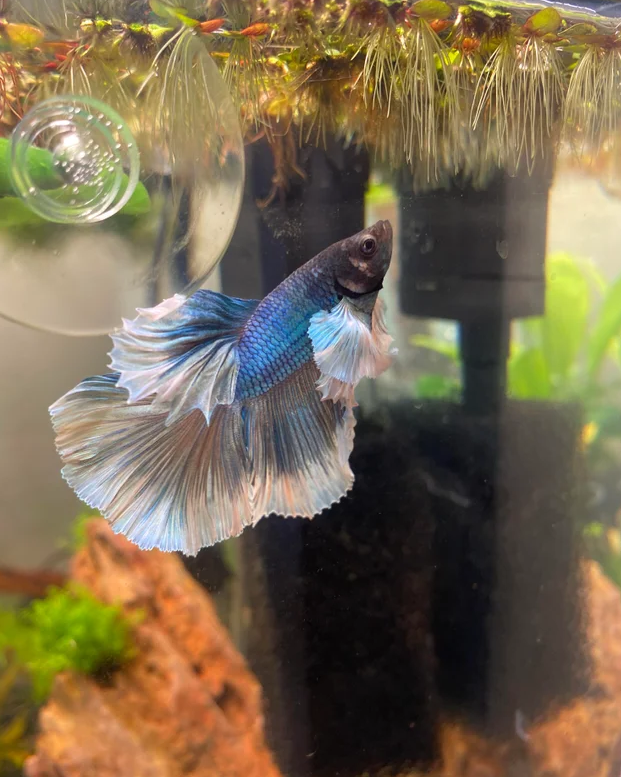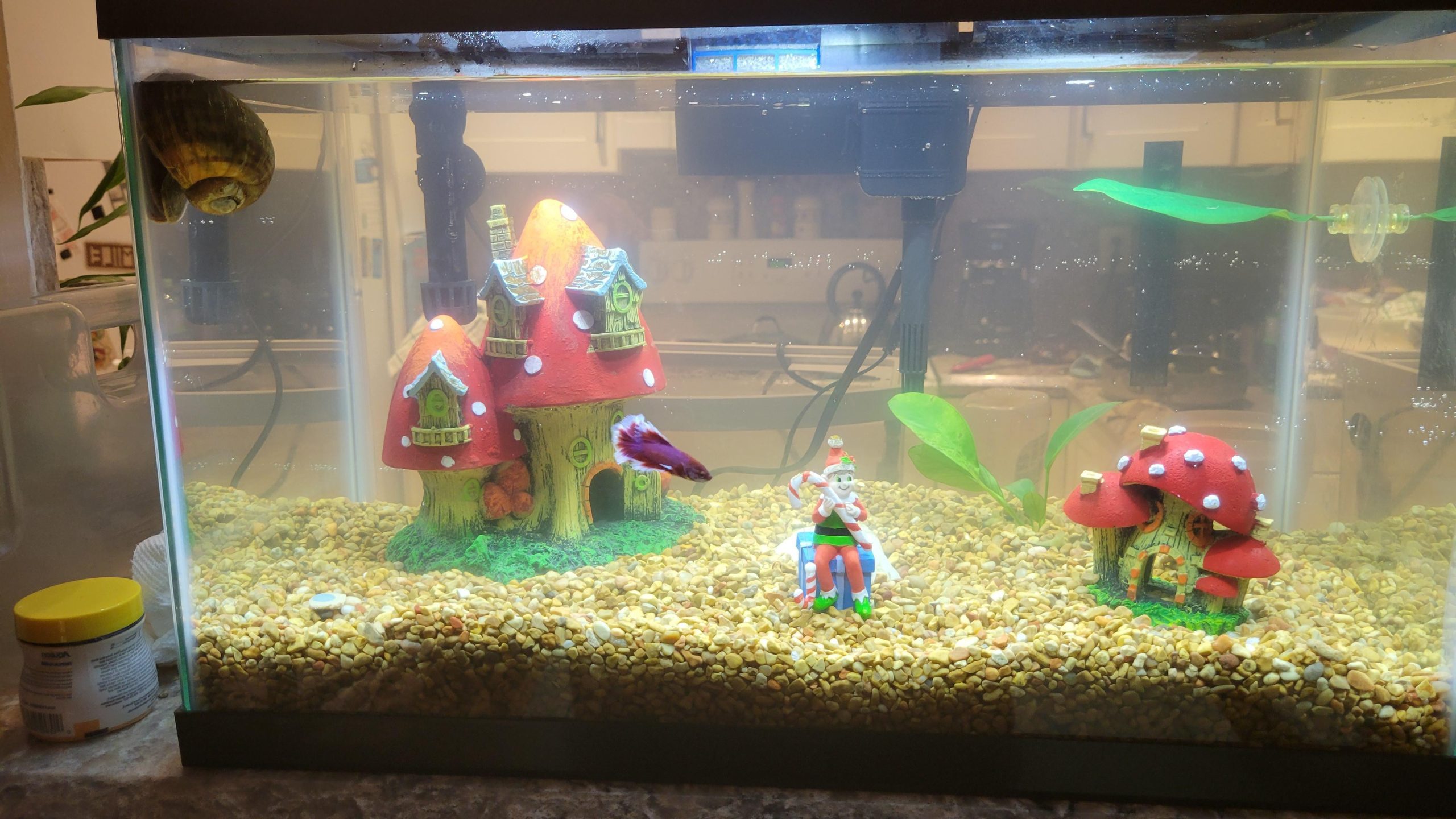Bettas have a reputation for being violent and possessive, and this reputation precedes them. Additionally, betta fish (Betta splendens) are referred to as “Siamese fighting fish” or “Japanese fighting fish.” They are not well-known for being hospitable to other fish. Finding a tank mate for a betta is difficult, as they are not particularly amicable toward one another. Despite the fact that Bettas come in a variety of varieties, they all possess one common character attribute.
Selecting the incorrect tank companion for your betta can result in discomfort, injury, and even life loss for at minimum to one of your fish.
It is not, however, impossible. Numerous fish species may coexist peacefully with betta. Fortunately, we are pleased to report that a variety of fish may coexist peacefully with a Betta. This contains a variety of different fish and invertebrates.
As soon as basic common sense guidelines are followed, all your fish will live happily in your biotope.
We’ll discuss some principles to follow and some thorough selections when looking for the right tank mate for your betta, as well as a look at the best compatilibility list for your betta tank mates to consider for your aquarium.
Checklist for Good Beta Tank Companion Practice
As you have a greater experience of your specific betta fish (each fish is unique) in particular, you’d understand the most effective methods that work on your fish, and you’d be able to add or remove rules from the above checklist as needed..
Betta Fish Companion Characteristics
❌ Avoid larger fish which might be frightening to the betta. Being in close proximity to a scary fish might quickly push the betta into fighting mode, which you do not want.
❌ Roughly comparable to the size issue, avoid brightly colored fish. A brightly colored fish might be scary to betta. As a result, you should refrain from acquiring a colorful tank companion for your betta fish.
❌ Betta fish are naturally hostile. They have the ability to attack another fish simply by being in their region. Therefore, one can picture the consequences if they coexist with nibblers or biters that are prone to assaults. If a tank mate nibbles at the betta, there will be retaliation.
❌ Generally you should avoid brightly colored fish, nervous fish, territorial and aggressive fish, top cruisers, predatory fish, slow moving fish and reptiles/amphimbians except of some frogs.
✔️ Across the betta compatilibity list you will find below, bottom feeders are fantastic fish to keep with betta and essentially are needed for all aquariums. The majority of bottom feeders can peacefully coexist with a betta fish.
Tank Enviroment
When it comes to tank mate selection, employ general fishkeeping practice. Do they have similar preferences for water quality and pH? Do they have similar tastes in crops and shrubs? How about the brightness?
Occasionally, you can foster the coexistence of multiple fish in your tank. Add a few decorations and living aquatic vegetation to the tank. If a fish becomes spooked on occasion, it will have certain hiding spots within your tank ornaments.
Water Cleaning and Temperature
Bettas are a kind of tropical freshwater fish. They thrive at water temperatures between 75 and 80 degrees Fahrenheit (24-26.5 degrees Celcius). Any ideal betta tank mate must also be comfortable in this temperature range. Certain compatible species may require you to adjust your aquarium’s water temperature to the lower end of this range in order for them to cohabitate successfully.
Activity and Habits
Considering that betta fish like pursuing neighbor fish, you’ll want to ensure that any prospective tank mates have swift fins in order to keep up with your combative betta. Alternatively, take the polar opposite and choose a sluggish bottom inhabitant who will not provide a temptation. Additionally, you should consider the possibility that nippy species will attempt to bite on your Betta’s lovely tail and fins. Make sure you’re looking for tank mates that aren’t going to bother each other.
Tank Size
The moment you consider adding another species to your Betta tank – or constructing a community or sorority aquarium of Bettas – tank size becomes a major consideration. It is critical not to attempt to squeeze everything in at once. Even when you’re adding merely invertebrates such as snails or shrimp, each creature requires their own area. A minimum of a 5 gallon tank is recommended for your betta. You may be best off leaving your Betta to their own aquariums in smaller aquariums.
Do not underestimate your Bettas’ territorial nature. They prefer to congregate in their preferred locations – sometimes at the apex, sometimes at the bottom of the tank, and occasionally nestled inside a plant or behind leaves. Avoid selecting a tank mate who does exhibit the same territorial tendencies and make sure you have proper ornaments. Choose a species that will not compete with your Betta for swimming space and prepare a lot of tank space if you choose one.
Best Female Betta Tank Mates
Generally, female bettas are less violent and territorial than masculine bettas. This gives them greater leeway in selecting tank mates.
Females are less concerned with the colors of their tank mates, which allows you to maintain more brightly colored fish in the tank with them.
Females are less colonial than males, which means they are less concerned with other fish entering their area. This enables for the addition of additional fish and somewhat bigger fish to the aquarium.
This, however, will vary according to the character of each fish, since some will be more hostile than some others.
It is critical that the fish breed you pick do not have a reputation for nibbling at other fish’s tails.
- Panda Cory
- Pygmy Cory
- Gold Tetra
- Penguin Tetra
- Mosquito Rasbora
- Yoyo Loach
- Clown Loach
- Clown Pleco
- Blue Tetra
- Red eye Tetra
Best Male Betta Tank Mates
Having male betta fish, your tank partner selections are limited, and you must exercise caution when considering which species to introduce to the tank. Males are extremely aggressive and hostile, and they despise having their private space violated.
Male hostility is also increased when other brilliantly colored fish of equal size are present. Avoid red-colored fish in particular, as this hue is often associated with antagonism in the wildlife realm.
Slow cruising fish are not really recommended, as they are prone to be assaulted.
Lengthy finned species are not advised since they are readily confused with another betta male fighting fish and are hence prone to be murdered.
- Colombian Tetra
- Head and Tail Light Tetra
- Dawn Tetra
- Green Neon Tetra
- Black Line Rasbora
- Snowball Pleco
- Candy Striped Pleco
- Zebra Loach
- Albino Cory
- Bristle Nose Pleco
Best Tank Mates For Betta Sororities
A betta sorority is a group of at least five female betta fish in a tank. Additionally, it is referred as as a betta harem.
While females are often less violent than males, this is not always the case, since they can be vicious and aggressive.
As a result, you must still select your tank mates carefully. The fish you select should match the same requirements outlined previously. They should be swift swimmers and shoaling varieties that are naturally calm and don’t nibble fins. Moreover, you can also pick bottom-dwelling fish species.
It is recommended that a sorority tank be housed in a wider aquarium with a minimum capacity of 30 gallons to 100 gallons. The aquarium should include several hiding places, such as vegetation or decorations, as well as a huge a swimming area besides plants.
- Black Neon Tetra
- Guppies
- Cory Catfish
- Cherry Barbs
- Neon Tetra
- Guntea Loach
- Ghost Shrimp
- Adult Cherry Shrimp
Best Tank Mates for Bettas: Compatibility List
Even if you provide ideal and acceptable living conditions, antagonistic fish will be unable to associate with any other type of fish.
It is definitely prohibited to have two male betta fish in the same aquarium due to the fact that battles between them will occur until one of the fish dies.
The following is a list of fish that are compatible with bettas.
- Neon Tetra
- Black Neon Tetra
- Rummy-nose Tetra
- Ember Tetra
- Cardinal Tetra
- Diamond Tetra
- Glowlight Tetra
- Silver Tip Tetra
- Harlequin Rasbora
- Fire Rasbora
- Endlers
- Female Guppy
- Celestial Pearl Danio
- Cory Catfish
- Otocinclus Catfish
- Kuhli Loach
- Pleco
- Glass Catfish
- White Cloud Mountain Minnow
- Platy (Short-finned)
- Short-fin Molly
- Mystery Snail
- Nerite Snail
- Malaysian Trumpet Snail
What Fish Can Live With Bettas: Full Tank Size List
Betta Mates for 2.5 Gallon Tank
- Mystery snail
- Ghost shrimp
Betta Mates for 3 Gallon Tank
- Nerite snail
- Cherry shrimp
- Marimo moss balls
Betta Mates for 5 Gallon Tank
- African dwarf frog
- Amano shrimp
- Kuhli loach
- Mystery snails
- Feeder guppies
- Bladder snails
- Ramshorn snails
- Red crystal shrimp
Betta Mates for 10 Gallon Tank
- Neon tetra
- Amano shrimp
- Ember tetra
- White cloud minnow
- Silver tip tetra
- Pygmy corydora
- Panda corydora
- Malaysian-trumpet snails
- Assassin snails
- Harlequin Rasbora
Betta Mates for 15 Gallon Tank
- Pygmy corydoras (Corydoras pygmeaus)
- Corydoras hastatus
- Dwarf pencilfish (Nannostomus marginatus )
- Least Killifsh (Heterandria formosa )
- Mosquito Rasbora (Boraras brigittae )
- Dwarf rasbora(Boraras maculatus)
- Rasborara merah (Boraras merah )
- Micro Rasbora(Boraras micros)
- Red micro rasbora(Boraras naevus )
- Boraras urophthalmoides
- Nano rasbora, Green dwarf rasbora (Microdevario nanus)
- Microrasbora gatesi/Burmese golden rasbora(Microdevario gatesi)
- Microrasbora kubotai(Microdevario kubotai )
- Harlequin Rasboras (Trigonostigma heteromorpha)
- Cardinal tetras (Paracheirodon axelrodi)
- Green Neon tetras (Paracheirodon simulans )
- Ember tetra (Hyphessobrycon amandae)
- Kuhli loach (Pangio semicincta)
- Guppies (Poecilia reticulata)
- Corydoras hasbrosus
Betta Mates for 20 Gallon Tank
- Corydoras sterbai
- Pitbull plecostomus (LDA25, Parotocinclus jumbo)
- Marbled Hatchet Fish (Carnegiella strigata)
- Rummynose tetras (Hemigrammus rhodostomus)
- Cherry barbs (Puntius titteya)
Betta Mates for 30 Gallon Tank
- Otocinclus catfish (Otocinclus macrospilus)
- Bronze corydoras (Corydoras aeneus)
- Corydoras julii
- Bristlenose pleco (Ancistrus cirrhosus
- Clown pleco (Panaqolus maccus)
Betta Mates for 55 Gallon Community Tank
- Neon Tetras
- Harlequin Rasboras
- Corydoras Catfish
- Kuhli Loaches
- Platies
- Zebra Danios
- Guppies (with shorter fins)
- Ember Tetras
- Cherry Barbs
Does Betta Fish Need a Tank Mate?
Do not be concerned if your Betta appears to be isolated in its aquarium. Bettas are not schooling fish species. Betta are loners. Therefore, if you retain a single betta or even a tiny Betta sorority cluster in a large community tank, you need not be afraid. You are not denying your Bettas of natural socialization or companion buddies, as you may believe they want.
If you don’t want to have a sorority group, you may be able to keep one man and numerous female fish. However, keep in mind that this is a recommendation, not a rigid law. A male betta may still harm, or attempt to murder, a female Betta in order to demonstrate his supremacy.
You may also discover that your females dislike socializing. Several flourish in a sorority tank, while others like to be solo.
Always be willing to modify and propose adjustments if your bettas are harassing one another or appear to be hostile or anxious. There is, however, one critical guideline about betta tank buddies. Never Combine Two Male Bettas.
If presented with the opportunity, 2 male Bettas would battle to the death.
Eventually from the two fighting bettas, one male Betta would ultimately give up and swim away in their natural environment. I n a small aquarium though, there is nowhere to conceal . This might cause stress, injury, and perhaps death to one or both of your male bettas. As a result, make sure you are not mixing two male Bettas! Nevertheless, in their native habitat, Bettas may cohabit with various fish and invertebrate species. While bettas will occasionally get territorial and force such fish away, they can usually coexist peacefully because the in danger organisms can swim away.
Can Betta Fish Live Together?
Two betta fish should not be kept in the same tank. They are some chances you can keep a female and a male or several females but this is not true when discussing two male betta fish.
Betta fish have a strong sense of territoriality. Apart from the fact that the two male betta fish will end up fighting and injuring one another, simply occupying the same area would stress them out significantly. Additionally, a stressed beta is more likely to engage in combat with its source of stress.
Unlike their male counterparts, female betta fish may coexist in the same aquarium. A tank with numerous female betta fish is referred to be a betta fish sorority aquarium. They continue being violent and territorial, though. Thus, while it is feasible, it is tough and requires considerable time and care on the part of the owner.
Therefore, if you are not an experienced fish keeper, we would not advocate starting with several betta on the same tank or a sorority tank.
Are other fish compatible with Bettas?
Apart from consuming little fish, any betta fish has an attitude for injuring other tank mates. Apart from their unease with little fish, betta frequently see their tank companion as harmful for them for no obvious reason.
Primarily, older fish species that possess physical qualities such as an exceptional tail and massive fins are considered harmful by bettas.
Additionally, a shared tank may house both female and male betta. Experts would attempt to determine if species can coexist peacefully with a betta. Close monitoring is required after this is accomplished.
Do Betta Fish Kill Other Fish?
Betta do not only kill to eat but mainly attack other fish to show dominance, especially to other male bettas. Due of their battling nature, betta fish can prey on other fish. These attacks lead fish to have open wounds that they are unable to close. A wound that isn’t properly cared for may be lethal, it is susceptible to contamination by a variety of bacteria, viruses and fungi.
Do Betta Fish Eat Baby Fish?
Betta fish will consume anything that is smaller than themselves. Bettas have a high probability of eating juvenile and baby fish. Different species that are the same size as a baby fish, such as tetras, cannot be kept beside a betta fish.
Bettas would prefer to kill and consume these little or young fishes if your tank lacks vegetation or ornaments that might help them disguise.
Due to the fact that Betta consume baby fish, some owners prefer to feed bettas with live young fish as food. Allow tiny fish to be placed in the tank with Betta for the sole purpose of being consumed by Betta. This is a poor practice for a Betta fish.This is why it is more than likely why they harm other fish in a community tank.
Can You Put Snails In With Bettas?
Typically, adding several snails to your betta’s aquarium will not make it aggressive. Occasionally, your betta will pick at it or nibble at it; this is very much out of curiosity than anger. This, of course, is always dependent on your betta, as every fish is unique. If you are aware that your betta is hostile, you must avoid adding any other tankmates. However, if you’re unsure, you may add one and observe.
Can You Put Shrimp In With Bettas?
As improbable as it may sound, cherry shrimp and bettas can live together. And we are not talking about replenishing your aquarium with cherry shrimps once every month, but the cherry shrimp in your aquarium will continue to survive and reproduce! While some bettas will not coexist with other tank mates, there are a variety of reasons for this, aside from their temperaments. Cherry shrimp though is compatible with betta fish.
Can Frogs Live With Bettas?
Yes Frogs can live with bettas. One of the frog species that match well a betta is the African dwarf frog. African dwarf frogs thrive in a biotope similar to that of bettas. They are well-mannered and low-maintenance. Additionally, they are fairly tiny, reaching a maximum height of 3 inches. Arguably, the most challenging aspect of caring for this frog is determining their food. African dwarf frogs enjoy meaty diets consisting of shrimps and blood worms. This suggests that caring for them will require a bit more effort and money. Nonetheless, they make excellent betta tank companions that will attract the attention of everybody who visits your shared tank.
Can Male And Female Betta Fish Live Together?
If you intend to maintain one male and one female betta fish together, you must ensure that the tank is not only large enough, but also long enough (40-50 gallons or even more). This will assist your female in avoiding your male if necessary and lessen the likelihood of hostility between the two fish.
Along with maintaining them in a huge tank, you should provide them with a plethora of vegetation and hiding spots. Your aquarium should be densely vegetated, obstructing your betta’s line of sight continually. Along with plant life, provide plenty of caves, driftwood, and other ornaments that will allow your bettas to establish their private area.
And keep in mind that while 30% of the furnishings in your tank can be rocks, driftwood, or custom items, the remaining 70% should be vegetation to help the couple feel extra at ease.
What Fish Are Not Compatible With Bettas?
Definite species of fish are incompatible with bettas. The following is a list of items NOT to include in your Betta tank as their not compatible:
Cold Water Fish
White cloud minnows, goldfish, and hillstream loaches, for example, do not make good tank betta companion mates due to their desired temperature ranges not overlapping (enough).
Large Catfish
These fish such Paroon Shark-Catfish (Pangasius Sanitwongsei), Zebra Shovelnose Catfish (Merodontotus Tigrinus) and Giraffe Catfish (Auchenoglanis Occidentalis) will get very big quite fast and they will quickly start preying on your bettas.
South American / African Cichlids
Cichlids are reported to be equally as violent and fight opportunistic as bettas. A betta with a cichlid in close proximity will be a quite vicious event. They dislike the very same water temperature and conditions too.
Fancy Guppies
Fancy Guppies, particularly if they’re multicolored, have a striking resemblance to bettas, and your betta will perceive them as a competition and act combative.
Goldfish
Goldfish make poor tankmates for bettas because they prefer significantly cooler water temperatures and they get very messy.
Gouramis
Both gouramis and bettas have anger management issues and have been known to take their frustrations out on one another.
Mollies And Swordtails
Mollies and swordtails will nip on your betta’s fins. They also thrive a quite higher pH.
(Pygmy) Pufferfish
Puffer are extremely nippy and will annoy your betta. Additionally, larger pufferfish prefer brackish or saltwater.
Tiger Barbs
Tiger Barbs are fierce and like sucking on Bettas’ slime coats. Tiger Barbs are similarly unable to resist nibbling at a betta’s lengthy fins and tail.
Chinese Algae Eaters
Chinese algae eaters are also known to be abrasive and angry. As they grow, they will attempt to remove a betta’s slime cover by sucking on it.
Other bettas
Certain betta species (for example, Betta imbellis and Betta mahachaiensis) are capable of coexistence with conspecifics. Betta splendens, on the other hand, will frequently engage in combat with other bettas.
Conclusion
Selecting the ideal companions for your betta fish might seem challenging, given their reputation for aggression. However, bettas can coexist peacefully with numerous other fish species in a well-structured community tank. The species highlighted in this list have been identified as some of the most compatible tank mates for betta fish. By choosing these species, you can create a harmonious and diverse community in your aquarium with confidence!





bookmarked!!, I like your web site!
Thanks for your blog, nice to read. Do not stop.
this post deserved to be shared…lots of gems!
I just got up from sleep and I am already reading your post. It means something! Really useful post. Thankx!
You saved my fish!
Thank you!